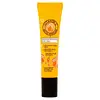What's inside
What's inside
 Key Ingredients
Key Ingredients

 Benefits
Benefits

 Concerns
Concerns

No concerns
 Ingredients Side-by-side
Ingredients Side-by-side

Water
Skin ConditioningGlycerin
HumectantDimethicone
EmollientPropylene Glycol
HumectantPEG-60 Hydrogenated Castor Oil
EmulsifyingPhenoxyethanol
PreservativeAvena Sativa Kernel Extract
AbrasiveDimethiconol
EmollientCarbomer
Emulsion StabilisingPolyacrylamide
Sodium Hydroxide
BufferingEthylhexylglycerin
Skin ConditioningC13-14 Isoparaffin
EmollientCaffeine
Skin ConditioningSodium Ascorbyl Phosphate
AntioxidantXanthan Gum
EmulsifyingLycium Barbarum Fruit Extract
AstringentDisodium EDTA
Laureth-7
EmulsifyingTerminalia Ferdinandiana Fruit Extract
AntioxidantCI 15985
Cosmetic ColorantWater, Glycerin, Dimethicone, Propylene Glycol, PEG-60 Hydrogenated Castor Oil, Phenoxyethanol, Avena Sativa Kernel Extract, Dimethiconol, Carbomer, Polyacrylamide, Sodium Hydroxide, Ethylhexylglycerin, C13-14 Isoparaffin, Caffeine, Sodium Ascorbyl Phosphate, Xanthan Gum, Lycium Barbarum Fruit Extract, Disodium EDTA, Laureth-7, Terminalia Ferdinandiana Fruit Extract, CI 15985
Water
Skin ConditioningDimethicone
EmollientGlycerin
HumectantNiacinamide
SmoothingPolysilicone-11
Isoamyl Laurate
EmollientCI 77163
Cosmetic ColorantButylene Glycol
HumectantAlbizia Julibrissin Bark Extract
MaskingBakuchiol
AntimicrobialCaesalpinia Spinosa Fruit Extract
Skin ProtectingDarutoside
Skin ConditioningGlycine Soja Extract
Skin ConditioningDipeptide Diaminobutyroyl Benzylamide Diacetate
Skin ConditioningGlycosaminoglycans
EmollientKappaphycus Alvarezii Extract
Skin ConditioningEthylhexylglycerin
Skin ConditioningPentylene Glycol
Skin ConditioningPropanediol
SolventDecyl Glucoside
CleansingPolyacrylate Crosspolymer-6
Emulsion StabilisingTetrasodium Glutamate Diacetate
Caprylyl Glycol
EmollientWater, Dimethicone, Glycerin, Niacinamide, Polysilicone-11, Isoamyl Laurate, CI 77163, Butylene Glycol, Albizia Julibrissin Bark Extract, Bakuchiol, Caesalpinia Spinosa Fruit Extract, Darutoside, Glycine Soja Extract, Dipeptide Diaminobutyroyl Benzylamide Diacetate, Glycosaminoglycans, Kappaphycus Alvarezii Extract, Ethylhexylglycerin, Pentylene Glycol, Propanediol, Decyl Glucoside, Polyacrylate Crosspolymer-6, Tetrasodium Glutamate Diacetate, Caprylyl Glycol
Ingredients Explained
These ingredients are found in both products.
Ingredients higher up in an ingredient list are typically present in a larger amount.
Dimethicone is a type of synthetic silicone created from natural materials such as quartz.
What it does:
Dimethicone comes in different viscosities:
Depending on the viscosity, dimethicone has different properties.
Ingredients lists don't always show which type is used, so we recommend reaching out to the brand if you have questions about the viscosity.
This ingredient is unlikely to cause irritation because it does not get absorbed into skin. However, people with silicone allergies should be careful about using this ingredient.
Note: Dimethicone may contribute to pilling. This is because it is not oil or water soluble, so pilling may occur when layered with products. When mixed with heavy oils in a formula, the outcome is also quite greasy.
Learn more about DimethiconeEthylhexylglycerin (we can't pronounce this either) is commonly used as a preservative and skin softener. It is derived from glyceryl.
You might see Ethylhexylglycerin often paired with other preservatives such as phenoxyethanol. Ethylhexylglycerin has been found to increase the effectiveness of these other preservatives.
Glycerin is already naturally found in your skin. It helps moisturize and protect your skin.
A study from 2016 found glycerin to be more effective as a humectant than AHAs and hyaluronic acid.
As a humectant, it helps the skin stay hydrated by pulling moisture to your skin. The low molecular weight of glycerin allows it to pull moisture into the deeper layers of your skin.
Hydrated skin improves your skin barrier; Your skin barrier helps protect against irritants and bacteria.
Glycerin has also been found to have antimicrobial and antiviral properties. Due to these properties, glycerin is often used in wound and burn treatments.
In cosmetics, glycerin is usually derived from plants such as soybean or palm. However, it can also be sourced from animals, such as tallow or animal fat.
This ingredient is organic, colorless, odorless, and non-toxic.
Glycerin is the name for this ingredient in American English. British English uses Glycerol/Glycerine.
Learn more about GlycerinWater. It's the most common cosmetic ingredient of all. You'll usually see it at the top of ingredient lists, meaning that it makes up the largest part of the product.
So why is it so popular? Water most often acts as a solvent - this means that it helps dissolve other ingredients into the formulation.
You'll also recognize water as that liquid we all need to stay alive. If you see this, drink a glass of water. Stay hydrated!
Learn more about Water